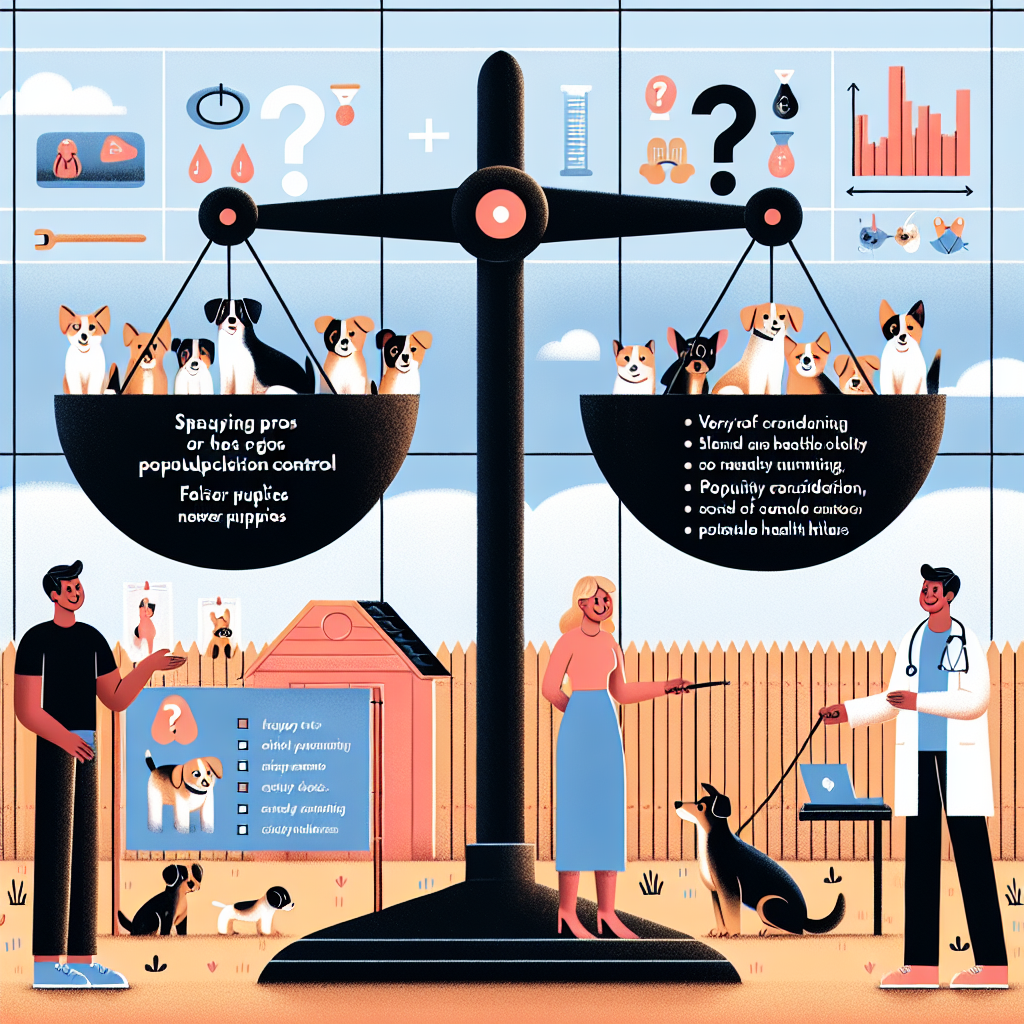Deciding whether to spay or neuter your dog is an important decision that every pet owner faces. It has become a topic of much discussion and debate among animal lovers, with passionate arguments on both sides of the fence. In this article, we explore the reasons behind spaying or neutering your furry friend, weighing the pros and cons to help you make an informed choice. So, grab your favorite four-legged companion and let’s unleash the truth about spaying and neutering!
Benefits of Spaying or Neutering
Preventing Unwanted Pregnancies
One of the primary benefits of spaying or neutering your dog is preventing unwanted pregnancies. Spaying, which refers to the surgical removal of the ovaries and uterus in female dogs, eliminates the possibility of them experiencing heat cycles and becoming pregnant. Neutering, which involves the removal of the testicles in male dogs, prevents them from fathering litters. By taking this step, you can avoid the challenges and responsibilities associated with caring for a litter of puppies, and contribute to reducing the pet overpopulation problem.
Reducing the Risk of Certain Health Issues
Spaying or neutering your dog can also help reduce the risk of certain health issues. In female dogs, spaying eliminates the risk of developing diseases of the reproductive system, such as ovarian cancer, uterine infections (pyometra), and mammary tumors. Neutering male dogs, on the other hand, can prevent testicular cancer and decrease the likelihood of prostate problems. By addressing these potential health concerns early on, you can help ensure a longer and healthier life for your beloved canine companion.
Managing Behavioral Problems
Spaying or neutering your dog can have a significant impact on their behavior. For male dogs, neutering can reduce aggressive tendencies, territorial marking behavior, and the urge to roam in search of a mate. This can make them more manageable and less likely to get into conflicts with other animals or humans. In female dogs, spaying helps prevent the behavioral changes associated with heat cycles, such as restlessness, vocalization, and attracting male dogs. By managing these behavioral problems, you can create a more harmonious and enjoyable environment for both you and your furry friend.
When to Spay or Neuter
Age Considerations
The appropriate age to spay or neuter your dog can vary depending on several factors, including their breed, size, and overall health. Typically, most veterinarians recommend spaying or neutering dogs between six to nine months of age. However, for larger breeds, it may be advisable to wait until they are fully matured, which can vary between 12 to 24 months of age. It’s important to consult with your veterinarian to determine the best timing for your specific dog, as they can provide personalized advice based on their individual needs.
Breed-Specific Factors
Certain breed-specific factors should be taken into consideration when deciding when to spay or neuter your dog. Large and giant dog breeds, such as Great Danes or Saint Bernards, may benefit from delayed spaying or neutering to allow for proper growth and development. On the other hand, smaller dog breeds may reach sexual maturity earlier, necessitating an earlier spay or neuter procedure. Additionally, some breeds may have a higher risk of certain health issues, and spaying or neutering them before those issues become a concern can offer preventive benefits. Discussing these breed-specific factors with a veterinarian can help you make an informed decision.

The Spay and Neuter Procedures
Spaying (Ovariohysterectomy)
During a spaying procedure, the veterinarian will make an incision in the abdomen of the female dog to remove the ovaries and uterus. This surgical procedure is known as an ovariohysterectomy. It is typically done under general anesthesia to ensure the comfort and safety of the dog. The recovery period after spaying can vary, but most dogs require a few days of rest and limited activity to heal properly. Your veterinarian will provide specific post-operative care instructions to ensure a smooth recovery for your furry friend.
Neutering (Orchiectomy)
When it comes to neutering, the veterinarian will remove the testicles from the male dog. This procedure, known as an orchiectomy, is also performed under general anesthesia. The incisions made during the surgery are generally small and heal relatively quickly. Like with spaying, dogs will need some recovery time after the procedure, during which they should be kept calm and monitored closely. Your veterinarian will guide you on post-operative care, including pain management and any necessary follow-up appointments.
Health Risks and Concerns
Surgical Risks
Like any surgical procedure, spaying and neutering carry a certain degree of risk. Complications can include bleeding, infection, adverse reactions to anesthesia, and poor wound healing. However, it’s important to note that these risks are relatively low, and most dogs recover without any complications. Trusting a qualified veterinarian with experience in these procedures can significantly reduce the chances of surgical risks, making it important to choose a reputable and licensed professional to perform the surgery.
Potential Changes in Behavior or Appearance
Some pet owners worry that spaying or neutering their dog will greatly alter their behavior or appearance. While there can be minor differences in behavior, such as reduced marking or roaming tendencies, most dogs still maintain their core personality and temperament after the procedure. Additionally, concerns about weight gain or changes in physical appearance are typically a result of lifestyle and diet rather than the surgery itself. By providing your dog with a healthy diet and regular exercise, you can help them maintain a balanced weight and appearance.

Male Dogs: Neutering
Preventing Roaming and Marking Behavior
Neutering male dogs can significantly reduce the urge to roam and engage in marking behavior. Unneutered male dogs often have a strong instinct to wander, especially when females in heat are nearby. By neutering your dog, you can help curb this behavior, making it easier to keep them safely within your home and neighborhood. Neutering can also minimize or eliminate marking behavior, such as urine spraying, indoors and outdoors, reducing the likelihood of unwelcome odors in your home.
Reducing Aggression and Dominance
Another benefit of neutering male dogs is the reduction of aggression and dominance-related behaviors. Hormonal changes and the presence of testosterone can contribute to aggressive tendencies, which can lead to conflicts or dangerous situations. Neutering helps regulate hormone levels, potentially lowering aggression and dominance behaviors. However, it’s crucial to note that individual variations in temperament and training methods play a significant role in a dog’s behavior, so appropriate training and socialization remain important regardless of neutering status.
Female Dogs: Spaying
Avoiding Heat Cycles and Potential Complications
One of the primary reasons to spay female dogs is to avoid the inconvenience and potential complications associated with heat cycles. Heat cycles, or estrus, occur roughly every six months and can last several weeks. During this time, female dogs may experience behavioral changes, discharge, and attract male dogs, which can lead to unwanted pregnancies. By spaying your female dog, you can eliminate heat cycles altogether, preventing the inconvenience and potential complications that come with them.
Preventing the Risk of Pyometra
Spaying can also protect female dogs from uterine infections, most notably pyometra. A pyometra is a serious condition where the uterus becomes infected and filled with pus. It typically affects older, unspayed dogs and can be life-threatening if not treated promptly. By spaying your female dog before they experience a pyometra, you can prevent the risk of this potentially dangerous infection, ensuring their long-term health and well-being.

Effect on Population Control
Preventing Overpopulation
One of the significant benefits of spaying and neutering dogs is preventing pet overpopulation. Each year, countless dogs end up in shelters or on the streets due to unplanned pregnancies. By spaying or neutering your dog, you are actively contributing to preventing the birth of unwanted litters and reducing the number of dogs that face a life without a home. This responsible decision can have a positive impact on the community and help alleviate the strain on animal shelters and rescue organizations.
Promoting Responsible Pet Ownership
Spaying or neutering your dog is not only about population control but also about promoting responsible pet ownership. By taking steps to prevent pregnancies and manage your dog’s behavior, you are showing a commitment to their well-being and the well-being of other animals in your community. Responsible pet ownership involves providing proper care, training, and socialization for your dog, while also considering the impact your dog may have on others. Spaying or neutering is an essential part of being a responsible and considerate pet owner.
Considerations for Responsible Pet Owners
Financial Responsibility
As a responsible pet owner, it’s important to consider the financial aspect of spaying or neutering your dog. The cost of the procedure can vary depending on various factors, including the location, the complexity of the surgery, and any additional services or medications required. It’s advisable to budget for this expense and consider it as a long-term investment in your dog’s health and overall well-being. Additionally, some organizations and clinics offer low-cost or subsidized spay and neuter programs, making it more accessible to pet owners with limited financial resources.
Ethical Considerations
Ethical considerations should also play a role in your decision-making process. By spaying or neutering your dog, you are actively participating in preventing unplanned litters and reducing the number of dogs that may suffer from neglect, abandonment, or euthanasia. Furthermore, responsible pet ownership involves considering the impact your dog may have on the well-being of other animals and the environment. By making the decision to spay or neuter, you are demonstrating compassion and respect for the welfare of animals as a whole.

Consulting with Veterinarians
Professional Advice and Guidance
When considering spaying or neutering your dog, consulting with a veterinarian is crucial. Veterinarians have the knowledge and expertise to provide personalized advice and guidance based on your dog’s breed, age, health status, and individual needs. They can help you understand the benefits, risks, and appropriate timing for the procedure. By discussing your concerns and questions with a trusted veterinarian, you can make an informed decision that is best for your dog’s well-being.
Surgical Options and Timing
Veterinarians can also provide detailed information about surgical options and timing. They can explain the differences between spaying and neutering, the surgical techniques involved, and the expected recovery period. They will consider your dog’s specific circumstances to determine the ideal timing for the procedure, taking into account factors such as their breed, age, and overall health. By collaborating with a veterinarian, you can ensure that the spaying or neutering process is carried out safely and effectively.
Personal Choice and Cultural Perspectives
Individual Preferences
Ultimately, the decision to spay or neuter your dog is a personal one. Each pet owner’s circumstances, priorities, and values differ, and these factors can influence the decision-making process. While there are clear benefits to spaying or neutering, it’s essential to consider your own preferences and assess them against the available information and expert advice. Evaluating your lifestyle, the environment in which your dog lives, and your long-term plans can help you make an informed decision that aligns with your individual preferences.
Regional and Cultural Influences
It’s worth noting that attitudes towards spaying and neutering can vary across regions and cultures. While it is a widely accepted practice in many countries, some communities may have different beliefs or ideas regarding the necessity or appropriateness of these procedures. It’s essential to respect and consider these perspectives while also weighing them against veterinary recommendations and the welfare of your dog. Ultimately, striking a balance between personal choice and cultural perspectives is a thoughtful approach towards responsible pet ownership.
In conclusion, spaying or neutering your dog offers a myriad of benefits, including preventing unwanted pregnancies, reducing the risk of certain health issues, and managing behavioral problems. The timing of the procedure should be carefully considered, taking into account age considerations and breed-specific factors. Spaying involves the removal of the ovaries and uterus in female dogs, while neutering requires the removal of the testicles in male dogs. While there are potential risks and concerns associated with both surgeries, the benefits often outweigh these factors. Neutering can help prevent roaming and marking behavior, as well as reduce aggression and dominance in male dogs. Spaying female dogs can avoid heat cycles, potential complications, and the risk of pyometra. Moreover, spaying and neutering significantly contribute to population control and responsible pet ownership. Responsible pet owners should consider the financial aspects and ethical considerations associated with these procedures. Consulting with a veterinarian can provide professional advice, surgical options, and guidance on timing. Ultimately, the decision to spay or neuter should be based on individual preferences and cultural influences, while keeping the well-being of your dog as the top priority.





